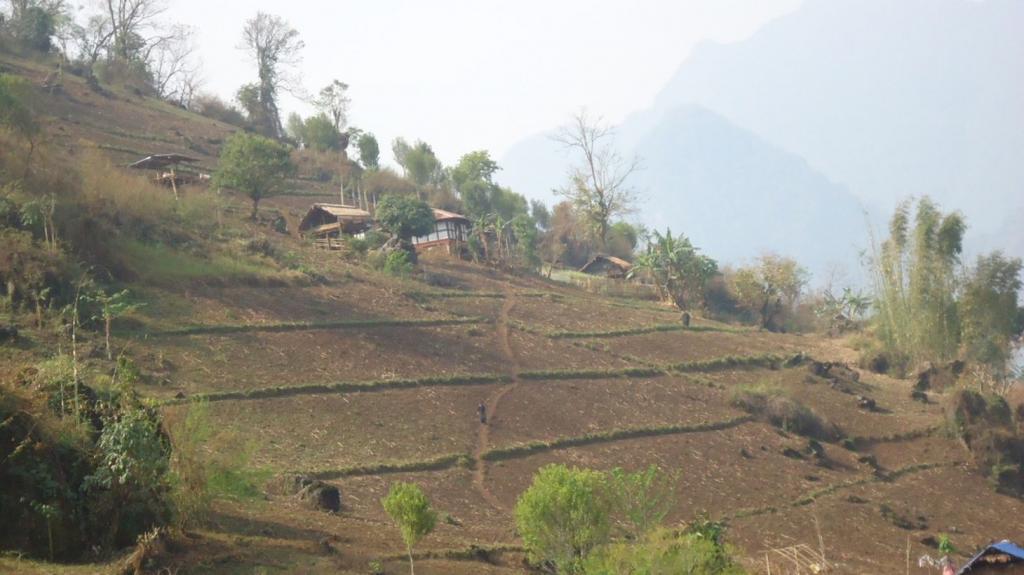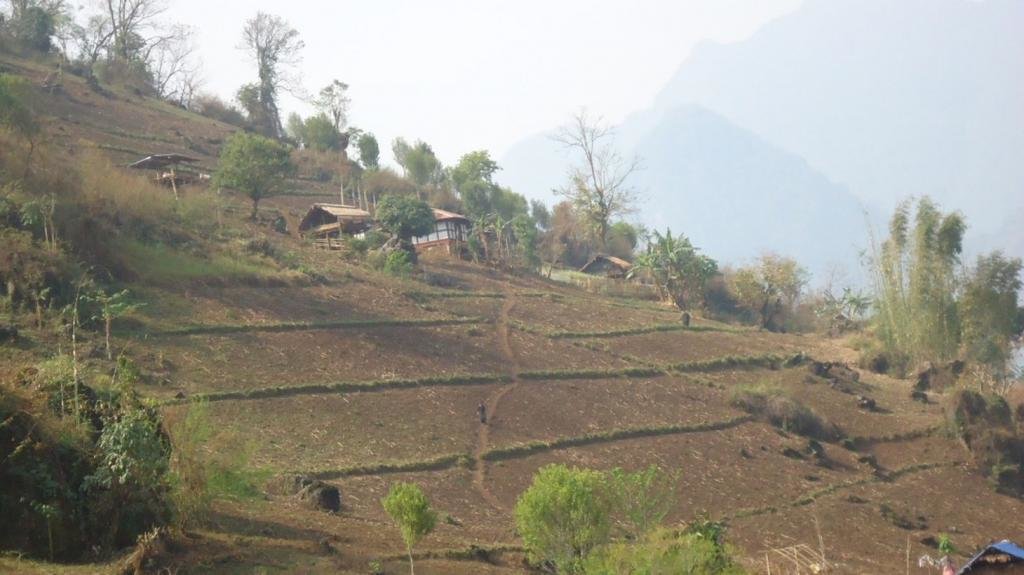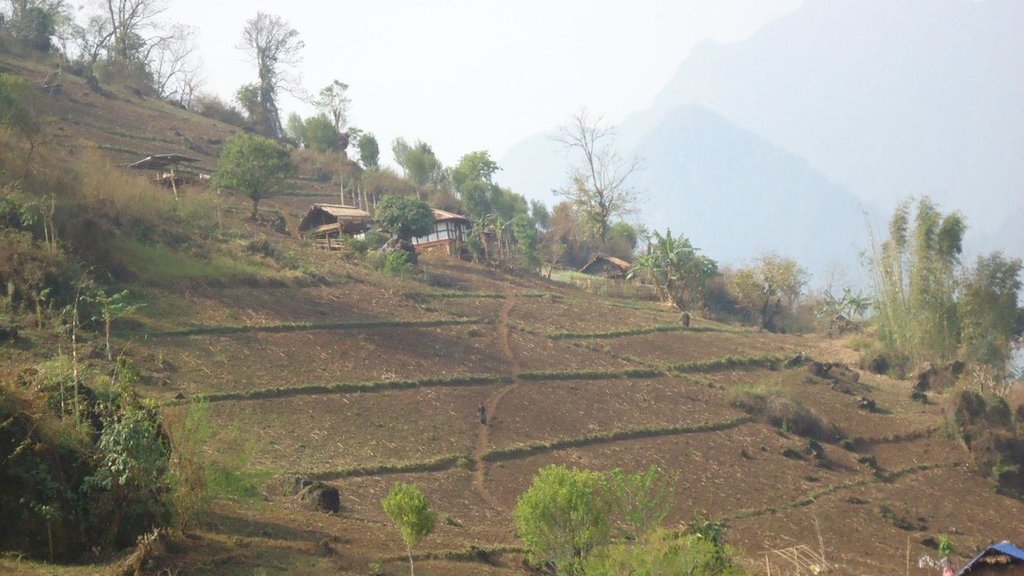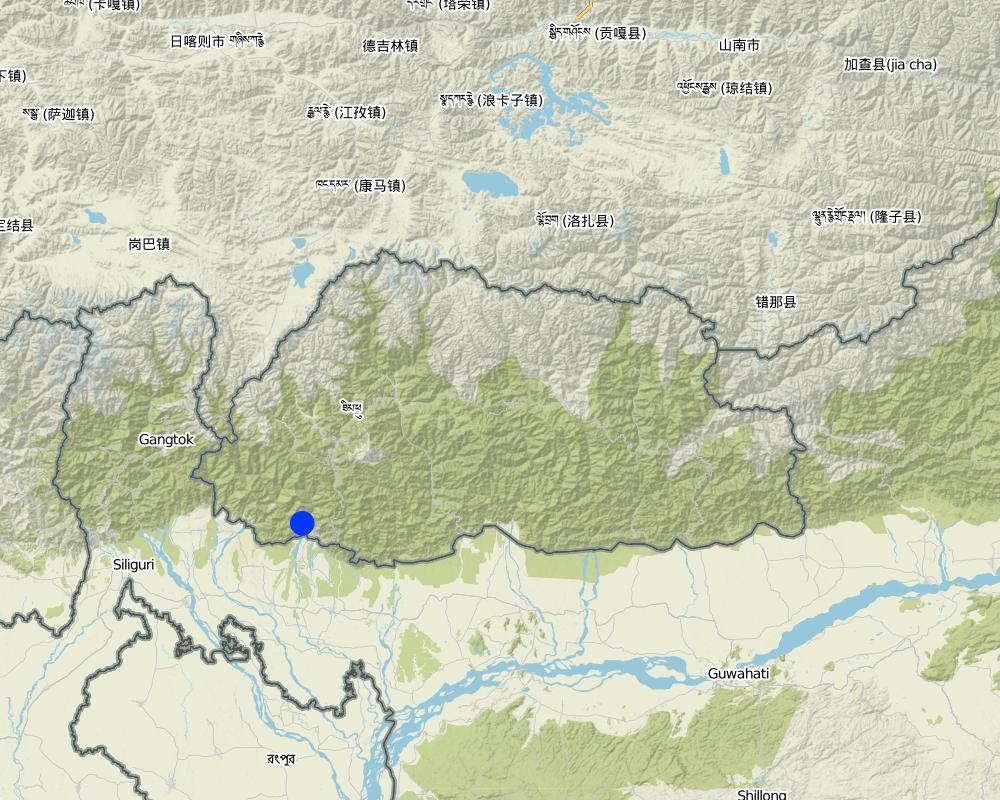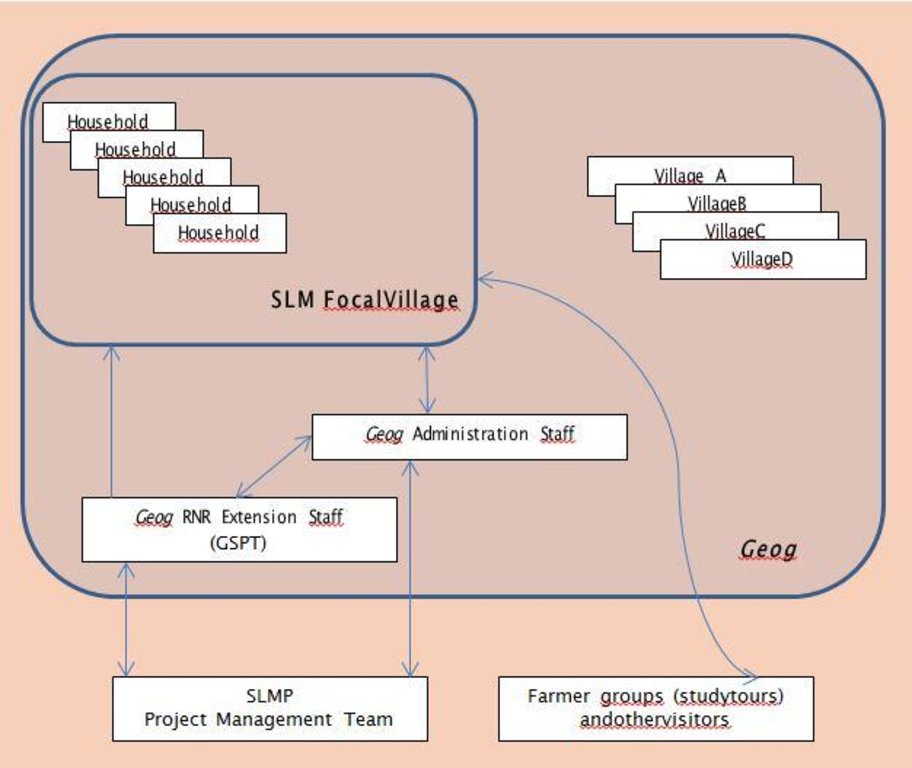SLM Focal Village [不丹]
- 创建:
- 更新:
- 编制者: Karma Dorji
- 编辑者: –
- 审查者: Fabian Ottiger
approaches_2490 - 不丹
查看章节
全部展开 全部收起1. 一般信息
1.2 参与方法评估和文件编制的资源人员和机构的联系方式
有助于对方法进行记录/评估的机构名称(如相关)
MoA (MoA) - 不丹有助于对方法进行记录/评估的机构名称(如相关)
National Soil Services Centre (National Soil Services Centre) - 不丹1.3 关于使用通过WOCAT记录的数据的条件
(现场)数据是什么时候汇编的?:
20/03/2011
编制者和关键资源人员接受有关使用通过WOCAT记录数据的条件。:
是
1.4 SLM技术问卷的参考
2. SLM方法的描述
2.1 该方法的简要说明
Focused support to a single village community to promote the widespread integrated implementation of SLM interventions.
2.2 该方法的详细说明
该方法的详细说明:
Aims / objectives: A SLM Focal Village is an approach to focus support to a particular village where a whole range of integrated SLM interventions is showcased in order to create visual impact and to serve as a demonstration site. The concept of a SLM Focal Village was developed in order to tackle the concern of dilution of impact caused by inclusion of all the villages and the households that are geographically very scattered and dispersed. Focal villages are selected at geog (block) level based on their accessibility, visibility for visitors and passers-by, severity of land degradation issues and interest shown by the village community.
Methods: Participatory SLM Action Planning is used to identify land-based problems, their causes and to discuss, select and prioritize specific targeted SLM interventions into a chiog (village) SLM action plan. Additional support is given to the village community to convert larger complexes of clustered land to more sustainable use with locally suited SLM practices. Popular interventions are stone bunding, grass hedgerows, bench terracing, bamboo and tree plantation and fodder development. The for-mation of labour-sharing groups is promoted in the SLM Focal Villages to ease high labour requirement for some SLM activities.
Stages of implementation: Where possible, integrated approaches are adopted, linking increasing vegetative cover of degraded or vulnerable areas with fodder development in marginal slope segments. FYM shed construction is combined with breed improvement and transition to stall feeding, providing manure for cropland. The SLM Focal Villages are used as demonstration sites and interested farmer groups on study tours and other visitors can get a quick impression of a variety of SLM activities showcased in a limited geographical area.
Role of stakeholders: The SLM Focal Villages are used as demonstration sites and interested farmer groups on study tours and other visitors can get a quick impression of a variety of SLM activities showcased in a limited geographical area.
Other important information: SLM Focal Villages require more guidance and monitoring by local extension staff and relatively higher budgets as the areas of land converted to SLM practices are often larger and thus related expenses for seeds, seedlings and other incentives like tools. In some focal villages additional labour-saving machinery is supplied, for example maize flour mill, oil expeller, rice huller, cornflake machine, etc. as an incentive to the community for taking up SLM interventions on comparatively larger scale..
2.3 该方法的照片
2.5 采用该方法的国家/地区/地点
国家:
不丹
区域/州/省:
Chhukha Dzongkhag
有关地点的进一步说明:
Phuntsholing geog, Serina chiog
Map
×2.6 该方法的开始和终止日期
注明开始年份:
2009
终止年份(若不再采用该方法):
2012
2.7 方法的类型
- 基于项目/方案
2.8 该方法的主要目的/目标
The Approach focused mainly on SLM with other activities (Advocay of implementation of various SLM techniques through focus village (chiog) approach)
- Creating a visible and tangible impact at chiog level through widespread implementation of SLM technologies
- Convert present fallow land and former slash-and-burn practice areas to more sustainable cropland with an improved fodder base
- Improve community sense and enhance sustainability of SLM approaches through group support
The SLM Approach addressed the following problems: - Inclusion of all households at village level in a large and geographically dispersed geog leads to dilution of (visual) impact and benefits.
- Targeting individual households makes it more difficult to create a focused demonstration area to showcase SLM interventions at village level
2.9 推动或妨碍实施本办法所适用的技术的条件
机构设置
- 阻碍
Transition of focus from individual household approach to labour-sharing approach, uniting lager groups of community members
Treatment through the SLM Approach: Group support, targeted training and guidance/monitoring
法律框架(土地使用权、土地和水使用权)
- 启动
The existing land ownership, land use rights / water rights greatly helped the approach implementation: Individual titled land tenure greatly help implementation of SLM activities as the land users have great commitment and feeling of ownership, getting direct benefits and leading in decision-making process.
工作量、人力资源可用性
- 阻碍
Larger areas to be treated with SLM interventions requires substantial work load of all households
Treatment through the SLM Approach: Labour-sharing groups to ease labour constraint and promote/enhance community bonding/sense
其他
- 阻碍
Lack of direct tangible impact of long-term SLM interventions
Treatment through the SLM Approach: Combining long-term SLM activities with short-term inputs and incentives and additional capacity building / awareness raising
3. 相关利益相关者的参与和角色
3.1 该方法涉及的利益相关者及其职责
- 当地土地使用者/当地社区
Serina chiog community
Households from vulnerable groups (lower “well-being class” after chiog “well-being ranking”) are involved as much as possible in SLM interventions.
- SLM专家/农业顾问
- 地方政府
Dzongkhag, geog and chiog administration together with the RNR extension staff and GSPs
- 国家政府(规划者、决策者)
RGoB, MoAF, DoA, NSSC, SLMP
- 国际组织
如果涉及多个利益相关者,请注明领导机构:
developed as result of internal review of project progress and impact
3.2 当地土地使用者/当地社区参与该方法的不同阶段
| 当地土地使用者/当地社区的参与 | 指定参与人员并描述活动 | |
|---|---|---|
| 启动/动机 | 互动 | Initial meetings to sensitize farmers and to create awareness of SLM issues |
| 计划 | 互动 | Participatory SLM action planning at chiog level; annual planning cycle, repeated for 3 years |
| 实施 | 互动 | Based on the chiog SLM action plan SLM interventions are implemented with input support and incentives; guidance and capacity building by municipality extension staff and geog SLM planners |
| 监测/评估 | 互动 | Participatory Monitoring & Evaluation meetings carried out by geogSLM planning team (GSPT) |
| Research | 无 |
3.3 流程图(如可用)
具体说明:
SLM focal village and its linkage with support providers
作者:
Hans van Noord (Schoutenkamp 43 Heteren The Netherlands)
3.4 有关SLM技术选择的决策
具体说明谁有权决定选择要实施的技术:
- 主要是土地使用者,由SLM专家提供支持
解释:
the annual participatory SLM Action Planning is key approach used to identify and prioritize SLM technologies for implementation at village level.
Decisions on the method of implementing the SLM Technology were made by mainly by SLM specialists with consultation of land users. based on the SLM Action plan for the village and amended, if necessary, by the findings of M&E meetings
4. 技术支持、能力建设和知识管理
4.1 能力建设/培训
是否为土地使用者/其他利益相关者提供培训?:
是
明确受训人员:
- 土地使用者
如果相关,请说明性别、年龄、地位、种族等。:
Whole community involved with SLM: inclusive approach to all 44 households
培训形式:
- 农民对农民
- 示范区域
- 公开会议
涵盖的主题:
A series of awareness raising activities related to identification of local land-based problems, its causes and possible SLM interventions through an annual SLM action planning and following implementation. This is combined with specific technical trainings focused on the SLM activities prioritized in the village SLM action plan.
4.2 咨询服务
土地使用者有权使用咨询服务吗?:
是
指明是否提供了咨询服务:
- 在土地使用者的土地上
说明/注释:
Name of method used for advisory service: Field visits and meetings; Key elements: technical guidance, awareness raising and group formation support
Advisory service is inadequate to ensure the continuation of land conservation activities
4.3 机构强化(组织发展)
是否通过这种方法建立或加强了机构?:
- 是,适度
具体说明机构的强化或建立程度:
- 本地
具体说明支持类型:
- 财务
- 能力建设/培训
- 设备
提供进一步细节:
Yes, SLM focal village development is a direct form of local institution support.
4.4 监测和评估
监测和评估是该方法的一部分吗?:
是
注释:
bio-physical aspects were ad hoc monitored by project staff, land users through observations; indicators: terrace area increase and area treated with stone bunds
bio-physical aspects were ad hoc monitored by project staff, land users through measurements; indicators: terrace area increase and area treated with stone bunds
technical aspects were regular monitored by project staff, land users through observations; indicators: Regular observations by project staff with land users of specific SLM interventions: progress, problems, areas for improvement
socio-cultural aspects were regular monitored by project staff, land users through observations; indicators: Regular observations on community / focal village approach through participatory M&E meetings; community sense, conflicts etc.
economic / production aspects were regular monitored by project staff, land users through measurements; indicators: Regular measurements by project staff and land users: crop yields, income, fodder and animal production
area treated aspects were regular monitored by project staff, land users through measurements; indicators: Regular measurements by project staff and land users: area of SLM interventions (hedgerows, stone bunds, bench terraces, # of check dams tec.)
no. of land users involved aspects were regular monitored by project staff, land users through measurements; indicators: Regular measurements by project staff and land users: number of households participating in each specific training and event (male/female)
management of Approach aspects were regular monitored by project staff, land users through observations; indicators: Regular observations by project staff and land users during participatory M&E meetings; ad hoc meetings with project management staff
There were few changes in the Approach as a result of monitoring and evaluation: Adjustment of technical interventions due to farmer feedback during participatory M&E meetings; review of annual SLM action plan leads to readjusted action plans based on evaluation with community on progress and issues.
There were few changes in the Technology as a result of monitoring and evaluation: Adjustment of technical interventions due to farmer feedback during participatory M&E meetings; review of annual SLM action plan leads to readjusted action plans based on evaluation with community on progress and issues.
5. 融资和外部物质支持
5.1 该方法中SLM组成部分的年度预算
如果不知道准确的年度预算,请给出一个范围:
- 10,000-100,000
注释(例如主要的资助来源/主要捐助者):
Approach costs were met by the following donors: international (World Bank GEF): 60.0%; government (RGoB): 20.0%; local community / land user(s): 20.0%
5.2 为土地使用者提供财政/物质支援
土地使用者是否获得实施该技术的财政/物质支持?:
是
5.3 对特定投入的补贴(包括劳动力)
- 设备
| 具体说明哪些投入得到了补贴 | 程度如何 | 对补贴做出具体说明 |
|---|---|---|
| maize floor mill, green net sheds, water drums | 部分融资 | |
- 农业
| 具体说明哪些投入得到了补贴 | 程度如何 | 对补贴做出具体说明 |
|---|---|---|
| 种子 | 充分融资 | maize, paddy, vegetables |
- 建筑
| 具体说明哪些投入得到了补贴 | 程度如何 | 对补贴做出具体说明 |
|---|---|---|
| CGI sjeets, water drums and houses | 充分融资 | |
- 其它
| 其它(具体说明) | 程度如何 | 对补贴做出具体说明 |
|---|---|---|
| incentive payment | 部分融资 | per unit area of hedge row and stone bunding |
如果土地使用者的劳动力是一项重要的投入,那么是不是:
- 自愿
注释:
Labour is mainly voluntary contribution by household, but partly compensated with cash and other material support for the more labour-intensive interventions such as stone bunding and hedgerow establishment; labour-saving groups also supported with tool sets
Tool sets partly financed; seeds and seedlings mostly fully financed; CGI sheets, green net and drums for FYM sheds, green net sheds and water collection drums fully financed; some labour-saving machinery fully financed such as maize flour mill as community incentive.
5.4 信用
是否根据SLM活动的方法给予信用值?:
否
6. 影响分析和结论性陈述
6.1 方法的影响
该方法是否帮助土地使用者实施和维护SLM技术?:
- 否
- 是,很少
- 是,中等
- 是,支持力度很大
Increased area under SLM treatment with improved fodder availability and formation of SLM related groups (labour-saving group etc.); former slash-and-burn practice area now converted into more sustainable land use; water sources protected and degraded areas afforested.
该方法是否改善了阻碍SLM技术实施的土地使用权/用户权问题?:
- 否
- 是,很少
- 是,中等
- 是,支持力度很大
Absentee land owners can complicate a full coverage of SLM interventions. The problem is unlikely to be overcome in the near future. Land ownership is a private matter, which is difficult to change land use without permission of abent land owner
Did other land users / projects adopt the Approach?
- 否
- 是,很少
- 是,中等
- 是,支持力度很大
Did the Approach lead to improved livelihoods / human well-being?
- 否
- 是,很少
- 是,中等
- 是,支持力度很大
In terms of increased yield, improved fodder availability and quality and increased production area; enhanced community bonding through group activities and related easing of labour constraints (labour-saving groups).
Did the Approach help to alleviate poverty?
- 否
- 是,很少
- 是,中等
- 是,支持力度很大
Through inclusion in labour-sharing groups labour constraint of vulnerable households addressed. Focus of hands-on training on land of most vulnerable households to give them first benefit and ensure inclusion.
6.2 土地使用者实施SLM的主要动机
- 增加生产
Small immediate increase, but good increase in long-term
- 增加利润(能力),提高成本效益比
- 减少工作量
labour-sharing groups: Reduced workload through improved land (with hedgerows, stone b
- 支付/补贴
incentives and inputs
- 规章制度(罚款)/执行
enforcement through GSPT/community
- 环境意识
environmental awareness
- well-being and livelihoods improvement
wish to improve food self-sufficiency and increase of continuous cropping area
6.3 方法活动的可持续性
土地使用者能否维持通过该方法实施的措施(无外部支持的情况下)?:
- 是
若是,请说明如何维持:
Village communities express commitment to continue focal village approach, but it remains to be seen if they actually are able to continue with various SLM activities without support post-project. The communities are intending to continue to convert ex slash-and-burn area to annual cropland, making use of labour-sharing group. This old traditional system is rejuvenated and therefore is more likely to be sustainable post-project.
6.4 该方法的长处/优点
| 土地使用者眼中的长处/优势/机会 |
|---|
|
reduced dependency on forest and tseri (How to sustain/ enhance this strength: maintenance of new annual crop land ) |
| more annual cropland through SLM interventions (How to sustain/ enhance this strength: maintenance of new annual crop land) |
|
better workability of developed cropland (stone bunding / hedgerows etc.) (How to sustain/ enhance this strength: maintenance of new annual crop land) |
| short-term inputs and subsidies enable the poorer households to take up log-term SLM interventions (How to sustain/ enhance this strength: targeted support to vulnerable households to maintain an inclusive approach) |
| 编制者或其他关键资源人员认为的长处/优势/机会 |
|---|
|
Holistic integrated village development enabling to showcase a variety of SLM interventions (How to sustain/ enhance this strength: Regular technical guidance and targeted capacity building efforts ) |
| Enables to convert larger areas of previous fallow land, or previously under slash-and-burn practice, to more sustainable cropland and reduces dependency on forest and slash-and-burn (How to sustain/ enhance this strength: Regular technical guidance and targeted capacity building efforts, combined with input support and guidance of labour-saving groups) |
| Pressure on communities to change land-use through governmental rule to stop slash-and-burn practice makes them very interested in adopting SLM (How to sustain/ enhance this strength: Regular technical guidance and targeted capacity building efforts, combined with short-term incentives) |
| Group formation process enables labour-sharing approach, which is very well appreciated (How to sustain/ enhance this strength: Regular technical guidance and targeted capacity building efforts) |
6.5 该方法的弱点/缺点以及克服它们的方法
| 土地使用者认为的弱点/缺点/风险 | 如何克服它们? |
|---|---|
| Increase of work load combined with demand for labour of other developmental activities (rural water supply, road construction etc.). Therefore 'underperformance' against set targets | Better seasonal planning, try to avoid busy agricultural season. |
| 编制者或其他关键资源人员认为的弱点/缺点/风险 | 如何克服它们? |
|---|---|
| Risk of dependency on incentives/inputs: spoon-feeding syndrome |
Continued support to community and labour-saving groups to support land conversion efforts |
|
Focus and concentration of efforts to one community might cause dissatisfaction among neighbouring villages |
Continue SLM support to other villages as planned; communicate reasons of selection clearly: transparency at municipality level. |
| Requires considerable input of labour by community, but clashes with other requirement of developmental activities such as drinking water supply, irrigation channel construction, electrification and farm road construction | Labour-sharing group to ease labour constraint |
7. 参考和链接
7.1 方法/信息来源
- 实地考察、实地调查
- 与土地使用者的访谈
链接和模块
全部展开 全部收起链接
无链接
模块
无模块


